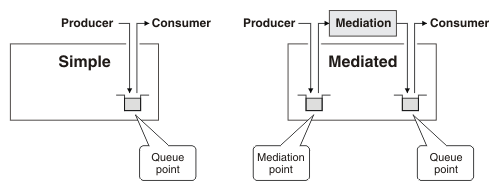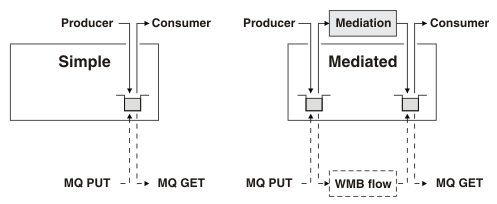Mediations
A mediation is a Java program that extends the messaging capabilities of WebSphere Application Server. Mediations can be used to simplify connecting systems, services, applications, or components that use messaging.
Mediations are used to process in flight messages. The type of processing a mediation can undertake includes:
- Transforming a message from one format into another.
- Routing messages to one or more additional target destinations.
- Add data to a message from a data source.
- Control message delivery based on some conditional logic in the mediation.
Use a mediation to process messages as an alternative to using a message-driven bean (MDB). A mediation has two advantages:
- It preserves the message identity. If an MDB re-sends a message after processing its body, it sends a new message with a new message ID and message properties. By preserving the message identity, using a mediation makes it easier to track messages.
- It is independent of the messaging technology. The mediation programming model provides a Service Data Objects (SDO) Version 1 interface to all messages and a common API for accessing properties and metadata.
When a message arrives at the mediation point, the mediation consumes the message and either transforms, subsets, aggregates or disaggregates the message. The message is then either forwarded to another destination or returned to the same destination, in which case, the message goes to the queue point where it can be consumed by the messaging application. This is shown in the following figure:

We can configure a destination so the mediation point or the queue point, or both are IBM MQ queues. If both are IBM MQ queues then a WebSphereMQ application can act as an external mediation as shown in the following figure:

WAS provides a mediation framework runtime that enables us to mediate messages. IBM Rational Application Developer and the assembly tools provide the tools needed to develop, assemble, test and deploy mediations.
We can mediate any type of destination in the service integration bus: inbound or outbound services, queues, and topic spaces. When we mediate a destination it is split into two parts called pre-mediated and post-mediated. The mediation receives messages from the pre-mediated part. Providing the messages are not redirected to another destination or discarded by the mediation, the mediation places messages on the post-mediated part. Messages on the post-mediated part are delivered to a message consumer. Splitting a destination into two parts allows asynchronous mediation of messages.
At deployment, the administrator can choose to have your mediation operate within a global unit of work to ensure transactional integrity, or to support concurrency if throughput of messages at a destination is important.
After deployment, the administrator configures your mediation for use at runtime using the WAS administrative console. The mediation is configured for use at a specific destination. The physical location is called a mediation point. The message processing provided by your mediation is started when the mediation point receives a message from the messaging runtime environment. The mediation operates on the message, for example transforming it, or forwarding it to other destinations.
Subtopics
- Mediation handlers and mediation handler lists
ediations are specified as a simple sequential list of mediation handlers. We must assemble and deploy the mediation handler list into an Enterprise Applications Archive and install it in WAS. Once the mediation is associated with a destination, it processes messages arriving at that destination. A mediation handler is the Java class that processes the messages. - Transactionality in mediations
We can configure a mediation handler to run within a global transaction. - Performance tuning for mediations
We can set the property sib:SkipWellFormedCheck in the administrative console to improve the performance of a mediation. Before we set a property to tune a mediation, we should consider the behavior of the mediation, to prevent the modification or loss of messages. - Performance monitoring for mediations
ediation performance monitoring is provided by the WAS Performance Monitoring Infrastructure (PMI). - Concurrent mediations
Several messages might be mediated concurrently, to achieve maximum throughput for a selected mediated destination. - Mediation points
A mediation point is a location in a messaging engine at which messages are stored and mediated. - Mediation context information
ediation context information is used to ensure that messages are processed correctly by parameterizing the mediation handlers, providing configuration information at runtime. For example, the name of a file to write to. - Mediations security
When bus security is enabled, authorization permissions are required to ensure that mediations can run, and undertake messaging operations securely on a service integration bus. There are mechanisms for mediations security, and implications for running mediations on a bus that spans multiple security domains. - Mediation application installation
A mediation application is an enterprise application (EAR file) containing a mediation handler enterprise bean project. Installing the EAR file into WebSphere (base) makes the mediation handler available for use at a destination. - Mediation programming
Using the capabilities of the mediation infrastructure, we can program mediations to customize the way that a service integration bus handles messages. You develop the mediation code within a component called a mediation handler, and add the mediation handler to a handler list, which is an application that is ready to deploy and install. We can connect a number of mediation handlers together in a mediation handler list to create a set of operations to run on a message.
Related: